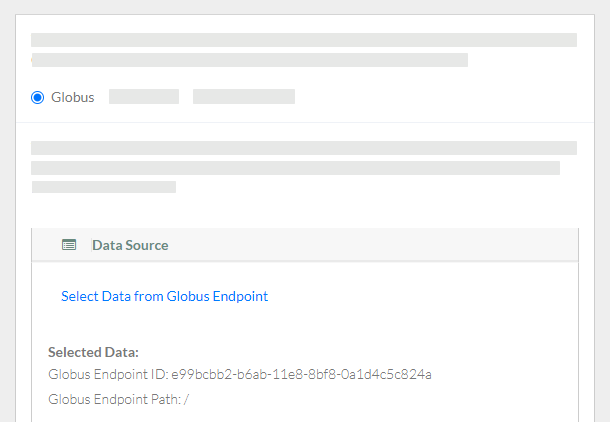 |
Page History
This page describes how to register multiple files. For prerequisites when using Globus with DME, refer to Preparing to Use Globus with DME. If If you want to provide metadata for each object (data file) or collection, also refer to Preparing a Metadata File for Bulk UploadRegistration.
For a video of this procedure, refer to Video of Uploading Data in Bulk via the GUInarrated slides demonstrating these instructions, refer to upload-Globus-slides.pptx.
To register data files:
- Log in as described in Logging In via the GUI. The Dashboard appears.Select a method:
- If you are not familiar with the data destination, browse for it, as described in Browsing for Data via the GUI. Navigate to and right-click the location where you want to register your data files. Click Add Bulk (Globus).
- If you are familiar with the data destination, select this method: In the left panel, click Register > Bulk (Globus).
Include Page shared step - select a bulk registration method shared step - select a bulk registration method Specify the data source:
Field Instructions Select Globus and click Select Data from Globus Endpoint. A
Select File(s)/Folder(s) from Globus endpoint Click the selection link. AGlobus page appears.
In Globus, select
an endpoint.
- Select the files or folders that you want to
- register into DME.
- Click Submit. The Register Bulk Data page
Include Criteria Use patterns to specify the source files to include. If you specify more than one pattern, the system considers a union of all patterns. For details, refer to Specifying Criteria for Bulk Upload. Exclude Criteria Use patterns to specify the source files to exclude. If you specify more than one pattern, the system considers a union of all patterns. For details, refer to Specifying Criteria for Bulk Upload. Criteria Type Specify the type of patterns in your criteria:
- Simple: For details, refer to Specifying Criteria for Bulk Upload.
- RegEx: For details, refer to the following page: https://docs.oracle.com/javase/8/docs/api/java/util/regex/Pattern.html
Multiexcerpt include MultiExcerptName ExitDisclaimer nopanel true PageWithExcerpt wikicontent:Exit Disclaimer to Include
Dry Run If you want to preview a list of the source file(s)/folder(s) that the system would register based on what you specified in the other Data Source fields, select this option. (This option tests only the Data Source entries. It does not test the Data Destination entries.) Bulk metadata file If you want to provide required metadata for each object or collection, click Choose File. Navigate to and select the prepared metadata file. (For details, refer to Preparing a Metadata File for Bulk Upload.) If the Base Path and Collection Type fields are available, specify the data destination:
- Select the base path specified by your group administrator. The system begins to populate values in the Collection Type field and the Collection Path field. (If you are a group administrator and want the Collection Type field to list more collection types, contact NCIDataVault@mail.nih.gov.)
Click Register. The system checks whether it can access the objects and collections you have specified, using the data you have entered:
- If not, the system displays an error message.
- If so, the system responds based on your selections and displays a message at the top of the Register Bulk Data page:
- If you selected the Dry Run option, the system displays a list of the source file(s)/folder(s) that it would have registered based on what you specified in the other Data Source fields. If necessary, revise your entries and click Register again until you are satisfied with the dry run list. When you are ready to perform the registration, click Register again.
- Otherwise, the system displays a message with the task ID of the registration request.
- reappears, with the Globus endpoint ID and path. (Depending on your selections in Globus, the Register Bulk Data page might also list the selected data files or folders.)
Include Page shared step - select metadata file shared step - select metadata file Include Page shared step - filter panel shared step - filter panel Include Page shared step - remaining portions of the Register Bulk Data page shared step - remaining portions of the Register Bulk Data page Include Page shared step - dry run GUI shared step - dry run GUI Include Page shared step - click Register shared step - click Register - When the system displays the task ID, consider clicking that link to visit the Data Registration Task Details page and view the progress of the registrationWhen the system displays the task ID, consider visiting the Upload Task Details page to view the progress of the upload. If you provided a metadata file, this page indicates any difficulty processing that metadata. For instructions, refer to Viewing Globus Upload Status.
...
